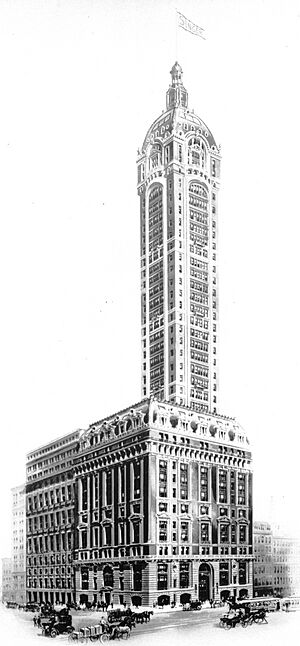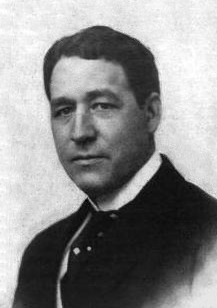Chatham Phenix National Bank and Trust Company of New York facts for kids
|
Formerly
|
Chatham and Phenix National Bank |
|---|---|
| Industry | Banking |
| Fate | Acquired in 1932 by Manufacturers Trust |
| Predecessors | Chatham National Bank (1812-1911) Phenix National Bank (1850-1911) |
| Founded | 1911 (as Chatham and Phenix National Bank) 1925 (as Chatham Phenix National Bank and Trust Company of New York) |
| Headquarters | Singer Building,
,
United States
|
|
Areas served
|
United States |
|
Key people
|
Louis G. Kaufman (President) George M. Hard (Chairman) |
| Divisions | Chatham Phenix Corporation, Chatham Phenix Allied Corporation |
The Chatham Phenix National Bank and Trust Company was a big bank in New York City. It was also connected to a company called the Chatham Phenix Corporation.
The bank started in 1911 as the Chatham and Phenix National Bank. This happened when Chatham National Bank joined with Phenix National Bank. The bank grew a lot by taking over smaller banks. For example, it joined with Mutual Alliance Trust Company and Century Bank in 1915. After these mergers, Chatham and Phenix National Bank became the first national bank to have many branch offices in the same city as its main office.
In 1925, the bank became the Chatham Phenix National Bank and Trust Company of New York. At this time, it had about $300 million in assets, which made it one of the ten largest banks in the United States. In 1932, the company joined forces with Manufacturers Trust.
Contents
History of Chatham Phenix Bank
How Phenix Bank and Chatham Bank Started
Phenix Bank began in 1812. It was first part of a company that made cotton supplies. At first, it was called Wire Bank because it focused on selling wire. In 1817, it became its own bank named Phenix Bank. Its main office was at 24 Wall Street in New York City.
Chatham Bank started in 1850. In 1910, George M. Hard, who had worked at Chatham National Bank for 50 years, became its chairman. Soon after, Louis Graveraet Kaufman became the president of Chatham National Bank. When Kaufman took over, the bank had about $7 million in deposits.
1911: Two Banks Become One
In 1911, the president of Chatham National Bank helped it join with Phenix National Bank. Chatham National paid $1.88 million to take over Phenix National Bank. This created the new bank called Chatham and Phenix National.
Together, the two banks had about $17.9 million in deposits by January 1911. The New York Times newspaper said that famous financier J. P. Morgan helped start the Chatham Phenix National Bank and Trust Company. Important families like the Astors and Goelets were also connected to the bank.
1915-1924: Growing with More Branches
In 1915, Chatham National Bank took over Century Bank and its branches. This made Chatham National the first national bank to have many branches in the same city as its main office. In January 1915, Chatham and Phenix National also bought Mutual Alliance Trust Company.
The leaders of Chatham and Phenix at that time included George M. Hard as chairman and Louis G. Kaufman as president. The merger was finished on January 14, 1915. The combined banks were worth $32 million. By the end of 1916, the bank had about $86 million in deposits. The Times reported that Chatham and Phenix was the only national bank with 12 local branches. On December 30, 1916, the bank moved its main office to the Singer Building.
In January 1921, the Times said that Chatham and Phenix National Bank was one of the few banks in New York that had more deposits that year. It also had no debt to the Federal Reserve Bank. In November 1921, Chatham and Phenix bought New York County National Bank, making it their twelfth branch. By then, Chatham and Phenix had about $163 million in deposits.
1925-1931: Adding "Trust Company" to the Name
In 1925, Chatham Phenix National Bank and Trust Company of New York was officially formed. This happened after it merged with Metropolitan Trust Company of New York, which had started in 1881. After this merger, the bank had about $300 million in assets. This made it one of the ten biggest banks in the United States at the time.
In 1929, Louis Kaufman became the chairman of Chatham Phenix Allied Corporation. This was an investment company with $50 million in capital.
1932: Joining Manufacturers Trust

In 1932, Chatham Phenix National Bank and Trust Company joined with the Manufacturers Trust. Manufacturers Trust had started in Brooklyn in 1914. Louis Kaufman became the chairman of the new combined company's executive committee. He left that role later the same year.
By the time Kaufman retired in 1932, the bank had grown 50 times bigger since it started in 1911. In 1961, Manufacturers Trust later joined with Hanover Bank to form the Manufacturers Hanover Trust Company.
Important People at the Bank
In early 1915, some of the important directors at the bank included Louis G. Kaufman, P. S. du Pont, August Belmont Jr., Edward Shearson, Edward E. Loomis, Elbert H. Garry, Frederick D. Underwood, and John Ringling. These people helped guide the bank's decisions and growth.
Bank Buildings and Locations
The first Chatham and Phenix building was at 192 Broadway in Manhattan. By 1916, the bank had been at Broadway and John Street for almost 50 years. In December 1916, the bank moved to the Singer Building. This new space was much larger, giving them more room to work. The Times newspaper described it as "one of the largest and finest banking rooms in the city."
By the end of 1916, the bank had 12 local branches. In 1917, a theater at 205 East 57th Street was changed into a bank building. It was designed by architects Mowbray & Uffinger. This building later became a theater again in 1933 after the bank joined Manufacturers Trust. The bank also opened new branches in other parts of New York City, like at Bowery and Grand Street.
The Chatham and Phenix Building was also located at 67 West 125th Street. This building was used for meetings by groups like the Harlem Property Owners' Association.


